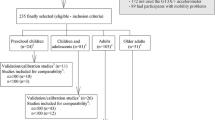Abstract
This paper aims to study the feasibility of using a smart mobile phone with an embedded accelerometer in gait pattern monitoring. The second motivation is to examine the impact of the accelerometer sampling frequency on gait analysis. A mobile phone and a standalone accelerometer sensor were simultaneously attached to subject’s lower back to record walking patterns. The degree of agreement between gait features derived from two devices was assessed in terms of average error rate, normalised limits of agreement and intra-class correlation. Various agreement levels were observed for three temporal features, three root mean square features, five regularity features and two symmetry features. The downsampling data were used to examine the impact of sample intervals on the gait features. Eleven out of 13 features have normalised mean difference less than 0.1 when sample intervals were less than 50ms. To carry out a further evaluation, the features derived from the downsampling gait data were used to classify subjects with chronic pain and health subjects, and a classification accuracy of 90% was achieved. The results showed that it is feasible and reliable to assess and monitor gait patterns based on spatio-temporal gait features derived from smart mobile phones with an embedded accelerometer.



Similar content being viewed by others
References
Bmob Business Consultancy. 2010. World mobile population now numbers 5 billion, http://www.themobileworld.com/. Accessed 10 July 2010
Huang Y., Zheng H., Nugent C., McCullagh P., McDonough S., Tully M. and Connor S.. Activity Monitoring Using an Intelligent Mobile Phone –A Validation Study. In 3rd ACM Int. Conf. Pervasive Technologies Related to Assistive Enviroments,Samos, Greece,2010.
Iso T., Yamazaki K.. Gait analyzer based on a cell phone with a single three-axis accelerometer. In Proc. 8th conf.Human-computer interaction with mobile devices and services, Helsinki, Finland, 2006; pp.141-144.
Begg R. and Palaniswami M.. Overview of movement analysis and gait features. In Computational intelligence for Movement Sciences: Neural Networks and Other Emerging Techniques, London, Uk: Idea Group Publishing; 2006, pp.1-69.
Mizuike C, Ohgi S, Morita S. Analysis of stroke patient walking dynamics using a tri-axial accelerometer. Gait Posture. 2009;30:60–4.
McClelland JA, Webster KE, Feller JA. Gait analysis of patients following total knee replacement: A systematic review. Knee. 2007;14:253–63.
Giansanti D, Macellari V, Maccioni G. New neural network classifier of fall-risk based on the Mahalanobis distance and kinematic parameters assessed by a wearable device. Physio Meas. 2008;29:N11–9.
Persch LN, Ugrinowitsch C, Pereira G, Rodacki ALF. Strength training improves fall-related gait kinematics in the elderly: A randomized controlled tria. Clin Biomech. 2009;24:819–25.
Auvinet B, Berrut G, Touzard C, Moutel L, Collet N, Chaleil D, Barrey E. Reference data for normal subjects obtained with an accelerometric device. Gait Posture. 2002;15:124–34.
Brandes M, Zijlstra W, Heikens S, van Lummel R, Rosenbaum D. Accelerometry based assessment of gait parameters in children. Gait Posture. 2006;24:482–6.
Zijlstra A, Bruin ED, Bruins N, Zijlstra W. The step length-frequency relationship in physically active community-dwelling older women. Eur J Appl Physiol. 2008;104:427–34.
Song Y., Shin S., Kim S., Lee D. and Lee KH.. Speed estimation from a tri-axial accelerometer using neural networks. 2007 Annual International Conference of the Ieee Engineering in Medicine and Biology Society, 2007; 1-16: 3224-3227.
Pendharkar G., Lai DTH., Begg R K., Detecting Idiopathic toe-walking gait pattern from normal gait pattern using heel accelerometry data and Support Vector Machines. Conf Proc IEEE Eng Med Biol Soc, 2008; pp.4920–3.
Zijlstra W, Hof AL. Assessment of spatio-temporal gait parameters from trunk accelerations during human walking. Gait Posture. 2003;18:1–10.
Senden R, Grimm B, Heyligers IC, Savelberg HH, Meijer K. Acceleration-based gait test for healthy subjects: Reliability and reference data. Gait Posture. 2009;30:192–6.
Hartmann A, Luzi S, Murer K, Bie RA, Bruin ED. Concurrent validity of a trunk tri-axial accelerometer system for gait analysis in older adults. Gait Posture. 2009;29:444–8.
Yang M., Zheng H., Wang H. and McClean S.. Assessing accelerometer based gait features to support gait analysis for people with complex regional pain syndrome. In 3rd ACM Int. Conf. Pervasive Technologies Related to Assistive Enviroments,Samos, Greece,2010.
Mizuike C, Ohgi S, Morita S. Analysis of stroke patient walking dynamics using a tri-axial accelerometer. Gait Posture. 2009;30:60–4.
Moe-Nilssen R, Helbostad JL. Estimation of gait cycle characteristics by trunk accelerometry. J Biomech. 2004;37:121–6.
Bland JM, Altman DG. Statistical methods for assessing agreement between two metonds of clinical measurement. Int J Nursing Studies. 2010;47:931–6.
Koch, Gary G. Intraclass correlation coefficient. In Samuel Kotz and Norman L. Johnson. Encyclopedia of Statistical Sciences. 4. New York: John Wiley & Sons; 1982. pp. 213–217
Yang MJ., Zheng H R., Wang HY., McClean S.. Feature selection and construction for the discrimination of neurodegenerative diseases based on gait analysis. In Proc. 3rd Int. ICST Conf. Pervasive Computing Technologies for Healthcare 2009, London UK.
Acknowledgment
The work was supported in part by the Vice-Chancellor’s Research Scholarships (VCRS) from University of Ulster. Thanks to Mr. William Burns for providing the software for collecting acceleration data used in the mobile phone.
Author information
Authors and Affiliations
Corresponding author
Rights and permissions
About this article
Cite this article
Yang, M., Zheng, H., Wang, H. et al. Assessing the utility of smart mobile phones in gait pattern analysis. Health Technol. 2, 81–88 (2012). https://doi.org/10.1007/s12553-012-0021-8
Received:
Accepted:
Published:
Issue Date:
DOI: https://doi.org/10.1007/s12553-012-0021-8




